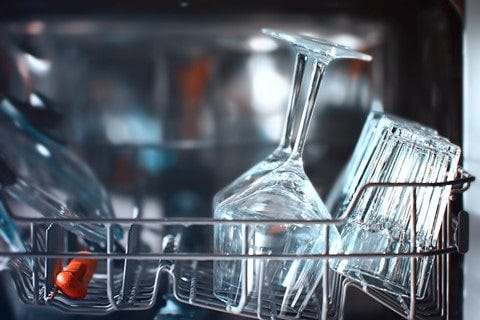
How to Use Your Dishwasher Correctly - A Step-By-Step Guide
This step-by-step guide will help you comprehend your dishwasher with a focus on understanding and utilizing different settings to suit your needs.

A dishwasher can be a life-saving device with the convenience that makes life easier, but it’s essential to know everything about a Dishwasher in order to use it correctly. A correct way not only extends your dishwasher’s life but also cleans dishes effectively. This step-by-step guide will help you comprehend your dishwasher with a focus on understanding and utilizing different settings to suit your needs.
Step 1 - Load the Dishwasher
Properly loading your dishwasher is essential even before considering the settings. Begin by scraping off any leftover food and clearing away substantial debris from your dishes. Arrange plates, bowls, and cookware to enable unobstructed water flow. Start loading the dishwasher from the bottom and then go upwards. This way you will be able to use the dishwasher more conveniently and effectively.
To prevent water accumulation, position items with curved surfaces downward. For utensils, utilize the assigned cutlery tray or basket to prevent hindering the spray arm's movement. Based on your load, you can use the program settings for more effective cleaning.
Step 2 - Choose the Right Detergent for your Wash
Choosing the appropriate detergent is a critical aspect of ensuring efficient dishwashing. Dishwasher detergents are available in diverse formats including powder, Quantum tablets, gel, and pods. It's advisable to refer to your dishwasher's manual to identify recommended detergents, as opting for an unsuitable variant can yield unsatisfactory outcomes.
Furthermore, it's beneficial to contemplate the integration of detergent additives such as rinse aids and cleaners. These supplementary agents can elevate the effectiveness of the cleaning procedure while safeguarding against the accumulation of minerals that can impede optimal performance.
Step 3 - Understanding the Programs and Wash Cycles
Comprehending the array of settings is pivotal when it comes to making the most of modern dishwashers. These settings and program cycles are completely based on the load size, load type etc. as per the dishwashing requirements. It's imperative to acquaint yourself with the various settings accessible on your dishwasher to ensure optimal performance.
Wash cycles and programs may differ with each dishwasher, but the most common program settings are here:
- Normal Cycle - This can be used for everyday load. This cycle usually creates a balance of efficacy and energy efficiency.
- Heavy Cycle - Sometimes, you have pans and pots that are too soiled and look like a challenge, so a heavy or a hard cycle is the recommended option. This is not energy efficient and uses more water than other cycles as it generates more pressure from the water spraying jets to ensure deep cleansing of heavily soiled pots.
- Quick or Express Cycle - In instances where time is of the essence, this shorter cycle proves invaluable. It efficiently rejuvenates slightly dirty dishes in a fraction of the time.
- Energy-Saving Mode - Some Dishwashers have this feature as it conserves more energy. You will find this mostly in A+ rated dishwashers or above.
Step 4 - Some Additional Settings
These settings are mostly available in newer models. Apart from the main cycle, these settings can be used at your convenience to either save time or make your dishwashing experience more effective.
- Delay Start: This feature lets you schedule the dishwasher to start at a later time, which can be useful if you want to take advantage of off-peak energy hours.
- Dry Cycle: Choose between air drying and heat drying. Heat drying is more efficient but may not be safe for all materials. Please ensure your dishes are dishwasher safe before using the heat drying method.
- Auto Cleaning: This setting is used to clean the dishwasher itself. The dishwasher gets dirty from the inside and needs a thorough cleansing. Auto cleaning the dishwasher will ensure the filter does not get clogged.
Step 5 - Load Detergent and Start the Cycle
Add the recommended amount of detergent to the dispenser based on your dishwasher's instructions. Make sure not to overload the dispenser, as this can lead to poor cleaning results. Select the desired wash cycle and any additional settings. Close the dishwasher door securely and press the start button.
Step 6 - Maintenance and Care
Maintenance should be considered important as running the dishwasher not only extends the device’s life but also ensures consistent performance. Additionally, a well-maintained dishwasher is more hygienic, preventing the growth of bacteria and mold that can result from neglect. Consistent care and attention to detail will help you get the most out of your dishwasher investment.
Clean the Filter:
The dishwasher's filter is a vital component that traps food particles and debris, preventing them from clogging the spray arm and affecting cleaning performance. Regularly inspect the filter, typically located at the bottom of the dishwasher, and remove any accumulated debris. Rinse it under running water to ensure it's free from clogs. The frequency of this cleaning may vary depending on your usage but doing it every few weeks is a good practice.
Wipe Down the Interior:
After each cycle, take a moment to wipe down the interior of the dishwasher with a dry cloth. This helps prevent moisture buildup, which can lead to unpleasant odours and even mould growth over time. Pay special attention to the door gasket and the areas around the detergent dispenser and filter.
Check Spray Arms:
Inspect the spray arms for any obstructions or clogs that may hinder water distribution. If you notice debris or buildup on the spray arms, remove them carefully (consult your dishwasher's manual for guidance) and clean them thoroughly. This ensures that water can flow freely, reaching all dishes for a thorough cleaning.
Deodorize:
If your dishwasher develops unpleasant odours, it's essential to address them promptly. You can use specialized Dishwasher Fresheners or solutions designed to tackle odours and buildup; follow the manufacturer's instructions for these products. Another ultimate solution for a sparkling and odour-free dishwasher is to utilize Finish Dishwasher Cleaner.
Conclusion -
Employing your dishwasher effectively extends beyond the mere act of picking a wash cycle. It necessitates a holistic approach encompassing proficient loading methods, the selection of an appropriate detergent, and a thorough grasp of the diverse settings available. These elements collectively play a pivotal role in achieving dishes that are not just clean but also thoroughly sanitized.
By adhering to the comprehensive guidance provided in this step-by-step guide and gaining proficiency in manipulating your dishwasher's settings, you empower yourself to harness the full potential of this invaluable time-saving appliance. In doing so, you not only optimize the cleanliness and hygiene of your dishes but also enhance the durability of your dishwasher itself.
In essence, the key takeaway is that using your dishwasher is both a science and an art. Mastering the settings and techniques outlined herein allows you to embrace the convenience and efficiency that this modern appliance affords while simultaneously ensuring that it remains a dependable ally in your kitchen for the long haul.


